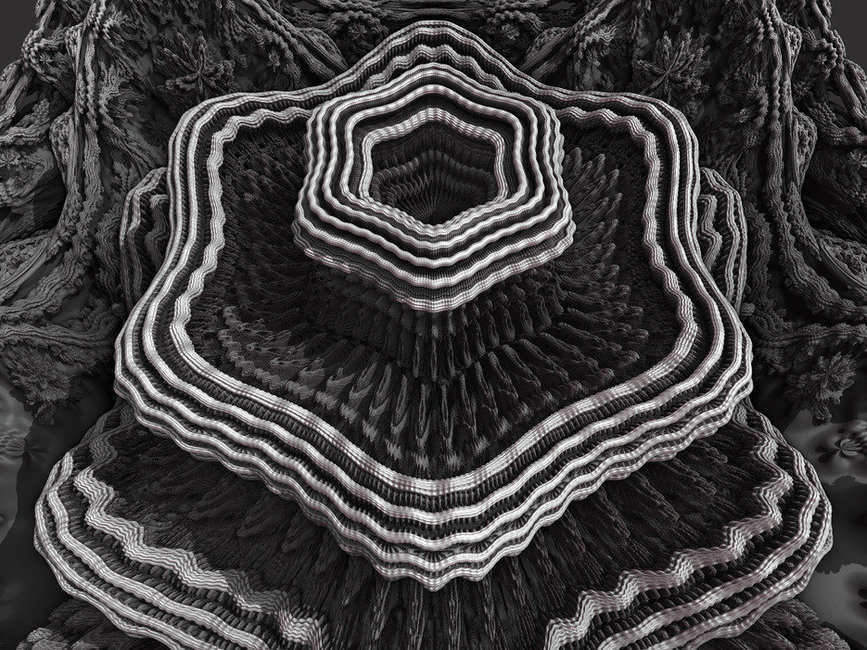It looks like you're using an Ad Blocker.
Please white-list or disable AboveTopSecret.com in your ad-blocking tool.
Thank you.
Some features of ATS will be disabled while you continue to use an ad-blocker.
9
share:
Being a web/graphics designer I come across a lot of crazy designs created by math. We have fractal art which is amazing:

Then we have the Mandlebot/Mandlebulb which is an entire 3-dimensional "world" created from math.

All of the images below come from the above object. Look at the one with what looks like stars on the right-my fav.

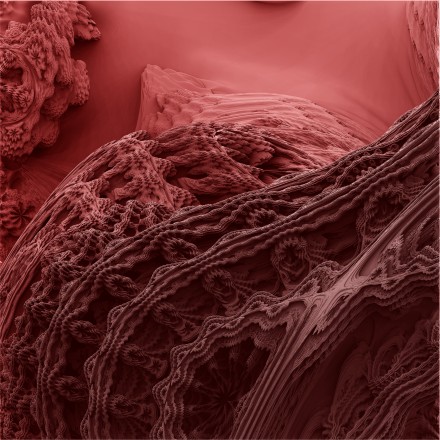
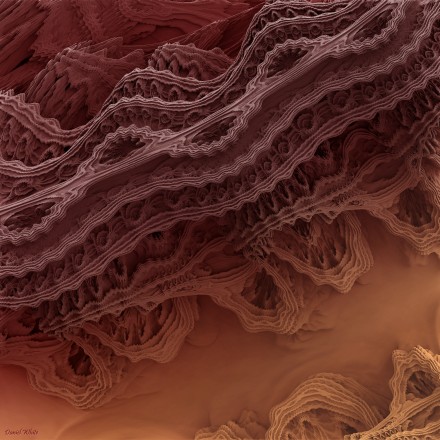
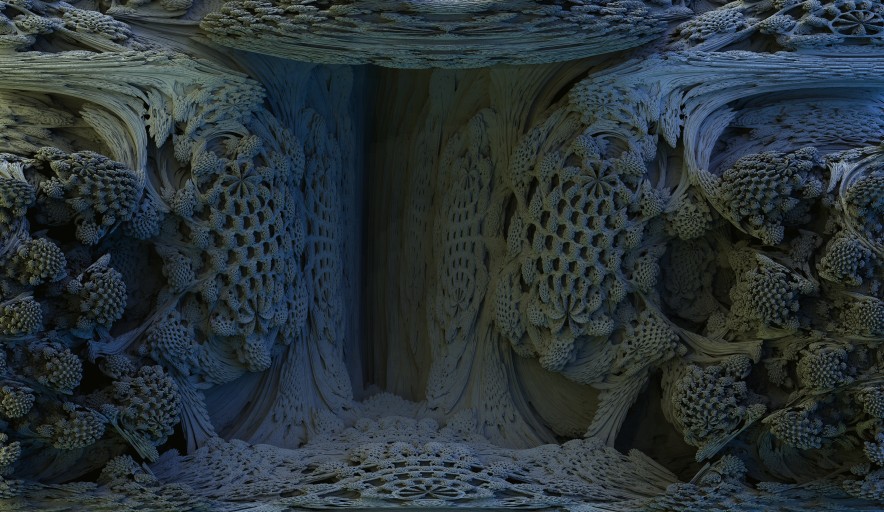
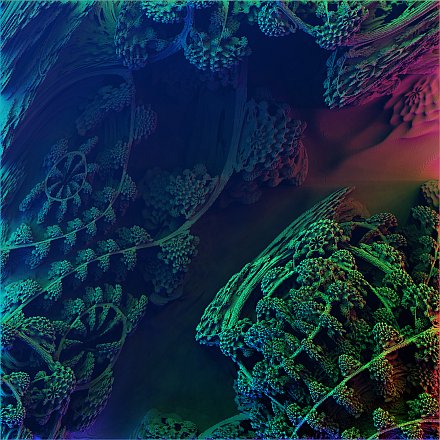
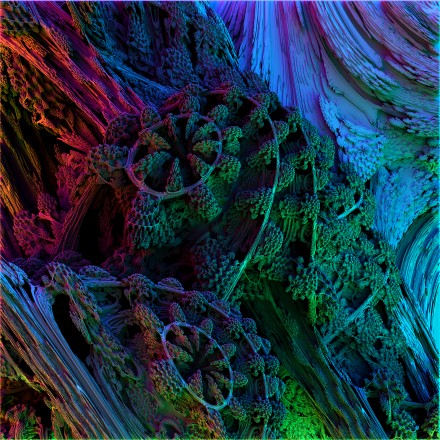

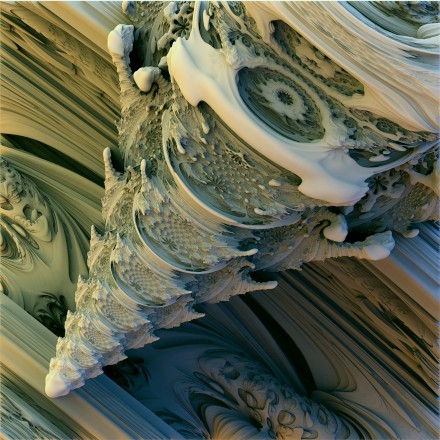
An awesome video inside the Mandlebulb:
Link:www.skytopia.com...
Hope you enjoyed!

Then we have the Mandlebot/Mandlebulb which is an entire 3-dimensional "world" created from math.
TIMESTAMP 08/11/2009. The original Mandelbrot is an amazing object that has captured the public's imagination for 30 years with its cascading patterns and hypnotically colourful detail. It's known as a 'fractal' - a type of shape that yields (sometimes elaborate) detail forever, no matter how far you 'zoom' into it (think of the trunk of a tree sprouting branches, which in turn split off into smaller branches, which themselves yield twigs etc.).
It's found by following a relatively simple math formula. But in the end, it's still only 2D and flat - there's no depth, shadows, perspective, or light sourcing. What we have featured in this article is a potential 3D version of the same fractal. For the impatient, you can skip to the nice pics, but the below makes an interesting read (with a little math as well for the curious).

All of the images below come from the above object. Look at the one with what looks like stars on the right-my fav.








An awesome video inside the Mandlebulb:
What's the formula of this thing?
There are a few subtle variations, which mostly end up producing the same kind of incredible detail. Listed below is one version. Similar to the original 2D Mandelbrot, the 3D formula is defined by:
z -> z^n + c
...but where 'z' and 'c' are hypercomplex ('triplex') numbers, representing Cartesian x, y, and z coordinates. The exponentiation term can be defined by:
[x,y,z]^n = r^n [ sin(theta*n) * cos(phi*n) , sin(theta*n) * sin(phi*n) , cos(theta*n) ]
...where:
r = sqrt(x^2 + y^2 + z^2)
theta = atan2( sqrt(x^2+y^2), z )
phi = atan2(y,x)
And the addition term in z -> z^n + c is similar to standard complex addition, and is simply defined by:
[x,y,z]+[a,b,c] = [x+a, y+b, z+c]
The rest of the algorithm is similar to the 2D Mandelbrot!
Here is some pseudo code of the above:
r = sqrt(x*x + y*y + z*z )
theta = atan2(sqrt(x*x + y*y) , z)
phi = atan2(y,x)
newx = r^n * sin(theta*n) * cos(phi*n)
newy = r^n * sin(theta*n) * sin(phi*n)
newz = r^n * cos(theta*n)
...where n is the order of the 3D Mandelbulb. Use n=8 to find the exact object in this article.
Link:www.skytopia.com...
Hope you enjoyed!
edit on 25-9-2011 by samlf3rd because: (no reason given)
edit on 25-9-2011 by samlf3rd because: (no reason
given)
edit on 25-9-2011 by samlf3rd because: Uploaded images properly
edit on 25-9-2011 by samlf3rd because: (no
reason given)
totally incredible!!! i loved this so beautiful,and so bizzar at the same time. i fell in love with fractal art 20 + years og,but i've never
seen 3-D fractals before! totally cool
reply to post by reficul
I know I want to get the program, I do use Apophisys, which is very awesome:apophysis.org...
That will keep you busy for a few years. Play with the attributes and go to town. The trick is to open the triangle editor-move them around, change their shape, create new ones, overlap them and wait a long long time to see the results. My son made a 3d tube somehow, it's now my desktop background.
I know I want to get the program, I do use Apophisys, which is very awesome:apophysis.org...
That will keep you busy for a few years. Play with the attributes and go to town. The trick is to open the triangle editor-move them around, change their shape, create new ones, overlap them and wait a long long time to see the results. My son made a 3d tube somehow, it's now my desktop background.
Here is a list of many different types of fractal programs, even for Mac's yeah!
fractalfoundation.org...
fractalfoundation.org...
edit on 25-9-2011 by samlf3rd because: (no reason given)
reply to post by samlf3rd
Beautiful pics. Look up "Fourier" calculus to see the link between this and our brains.
Beautiful pics. Look up "Fourier" calculus to see the link between this and our brains.
I am studying organic chemistry at the moment and while looking at this I am wondering...
...if it would be possible to plot the energy levels of the (infinite number of) organic compounds in this way. it makes a lot of sense that the distribution of energy in the universe would follow this type of plot.
so, in other words, when looking at the mandelbulb, all of the large and /or repetitive structures would represent stable compounds. and the chaotic areas would represent the energetic transitions between the compounds.
in fact, it makes so much sense, I cannot be the first person to have thought of it.
thanks for posting!
...if it would be possible to plot the energy levels of the (infinite number of) organic compounds in this way. it makes a lot of sense that the distribution of energy in the universe would follow this type of plot.
so, in other words, when looking at the mandelbulb, all of the large and /or repetitive structures would represent stable compounds. and the chaotic areas would represent the energetic transitions between the compounds.
in fact, it makes so much sense, I cannot be the first person to have thought of it.
thanks for posting!
reply to post by tgidkp
As I look at these pics and the video I wonder if this is the easiest way to describe the universe. Infinity explained visually? It never ends, because the math is infinite, like space and time.
As I look at these pics and the video I wonder if this is the easiest way to describe the universe. Infinity explained visually? It never ends, because the math is infinite, like space and time.
reply to post by tgidkp
You aren't the first to think of it, nope... however don't let that discourage you. We need more people thinking this way so let it shine!
Namaste!
You aren't the first to think of it, nope... however don't let that discourage you. We need more people thinking this way so let it shine!
Namaste!
Evasius already made a thread on this ;
www.abovetopsecret.com...
Just pointing that out for those who didn't know.
www.abovetopsecret.com...
Just pointing that out for those who didn't know.
new topics
-
God's Righteousness is Greater than Our Wrath
Religion, Faith, And Theology: 2 hours ago -
Electrical tricks for saving money
Education and Media: 5 hours ago -
VP's Secret Service agent brawls with other agents at Andrews
Mainstream News: 6 hours ago -
Sunak spinning the sickness figures
Other Current Events: 7 hours ago -
Nearly 70% Of Americans Want Talks To End War In Ukraine
Political Issues: 7 hours ago -
Late Night with the Devil - a really good unusual modern horror film.
Movies: 9 hours ago -
Cats Used as Live Bait to Train Ferocious Pitbulls in Illegal NYC Dogfighting
Social Issues and Civil Unrest: 10 hours ago
top topics
-
VP's Secret Service agent brawls with other agents at Andrews
Mainstream News: 6 hours ago, 9 flags -
Florida man's trip overseas ends in shock over $143,000 T-Mobile phone bill
Social Issues and Civil Unrest: 17 hours ago, 8 flags -
Cats Used as Live Bait to Train Ferocious Pitbulls in Illegal NYC Dogfighting
Social Issues and Civil Unrest: 10 hours ago, 8 flags -
Electrical tricks for saving money
Education and Media: 5 hours ago, 4 flags -
Bobiverse
Fantasy & Science Fiction: 17 hours ago, 3 flags -
HORRIBLE !! Russian Soldier Drinking Own Urine To Survive In Battle
World War Three: 14 hours ago, 3 flags -
Nearly 70% Of Americans Want Talks To End War In Ukraine
Political Issues: 7 hours ago, 3 flags -
Sunak spinning the sickness figures
Other Current Events: 7 hours ago, 3 flags -
Late Night with the Devil - a really good unusual modern horror film.
Movies: 9 hours ago, 2 flags -
The Good News According to Jesus - Episode 1
Religion, Faith, And Theology: 12 hours ago, 1 flags
active topics
-
Nearly 70% Of Americans Want Talks To End War In Ukraine
Political Issues • 12 • : Asher47 -
VP's Secret Service agent brawls with other agents at Andrews
Mainstream News • 39 • : Asher47 -
Electrical tricks for saving money
Education and Media • 4 • : Lumenari -
Cats Used as Live Bait to Train Ferocious Pitbulls in Illegal NYC Dogfighting
Social Issues and Civil Unrest • 19 • : WeMustCare -
New whistleblower Jason Sands speaks on Twitter Spaces last night.
Aliens and UFOs • 54 • : Ophiuchus1 -
DONALD J. TRUMP - 2024 Candidate for President - His Communications to Americans and the World.
2024 Elections • 514 • : WeMustCare -
The Acronym Game .. Pt.3
General Chit Chat • 7744 • : bally001 -
Truth Social goes public, be careful not to lose your money
Mainstream News • 128 • : Astyanax -
Sunak spinning the sickness figures
Other Current Events • 5 • : glen200376 -
SETI chief says US has no evidence for alien technology. 'And we never have'
Aliens and UFOs • 44 • : MikeDeGrasseTyson
9


